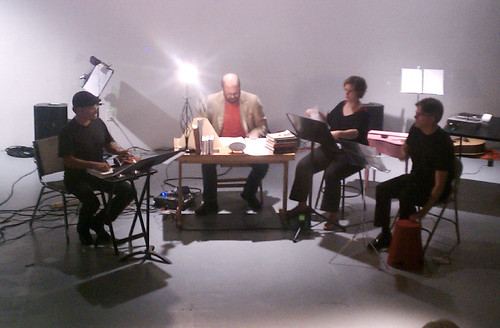Today we review the opening concert of the Thirteenth Annual San Francisco Electronic Music Festival (SFEMF). The concert was a tribute to John Cage on his centennial (one of many) and took place at SFMOMA. It specifically featured four of his conceptual pieces with chance processes or novel instrumentation.
The main included a performance of Cage’s Score Without Parts on SFMOMA’s rooftop terrace, conducted by Gino Robair with texts by Tom Djll. The performance was in conjunction with the opening of the museum’s intriguing minimalist design exhibition Field Conditions. There were even hors d’oeuvres served on tiles from one of the pieces in the exhibit. Unfortunately, because of another commitment I only arrived at the tail end of the performance, so I did not hear enough to reasonably review it.

[sfSoundGroup. Photo: PeterBKaars.com.]
The main concert opened with members of sfSoundGroup performing Cartridge Music. This is the same piece that concluded the Music of Changes: Variation VIII concert a few weeks earlier, and featured the same personnel: Matthew Goodheart, Kyle Bruckmann, Matt Ingalls, and Tom Dambly. However, I felt that this was a stronger performance. Some of this may have been the staging and the sound support, but it also seemed that the cues for various elements were crisper and tighter, and the selection of sounds to use with the contact mics (i.e,, “catridges”) was more focused and suited to the structure of the piece. As in all music, practice and review from earlier performances helps.
This was followed by a performance of Cage’s most famous work, 4’33”. Normally, the piece is for a single pianist, but this particular performance featured a laptop ensemble. After all, it is a festival of electronic music.

[4’33” performed with laptops. Photo: PeterBKaars.com.]
The performers (mostly members of SFEMF’s steering committee) sat in silence, as required by the score of the piece, with a few motions here and there. The audience mostly listened respectfully as well, I only noticed a few deliberate comments at soft volume. Thus, it was a successfully executed performance of the piece. I hope none of the laptops crashed.
The score for Fontana Mix, which is itself a work of art with curving lines and randomly distributed points, is actually a tool for generating other pieces. Aria is one such piece that Cage himself generated. For this performance, Fontana Mix with electronic sounds and Aria for voice were layered on top of one another, with Daniel Steffey and Christina Stanley performing the layers on electronics and voice, respectively.

[Daniel Steffey and Christina Stanley. Photo: PeterBKaars.com.]
My least favorite performance of a Cage composition was a boring and long version of Fontana Mix, so I had a little bit of trepidation. But this realization by Steffey and Stanley was vibrant and dynamic. Stanley’s vocals moved between numerous styles of singing (e.g., classical, popular, cabaret) and languages, punctuated by percussive strikes on found objects. Steffey’s foundation of electronic timbres was strong as well, with a lot of variation that left room for the vocals. Using these elements, they were able to realize genuine musical phrases and structure with a sense of narrative from the abstract scores.
The final performance of the evening was a realization of Variations II by Guillermo Galindo that featured a mariachi band. A mariachi band performing John Cage is certainly unusual, but in truth no different from any other interpretation of his scores with open instrumentation. For this performance, a four-piece group Mariachi Nueva Generación with traditional costumes and instrumentation, including violin, trumpet, the distinctive large guitarrón mexicano, and guitar.

[Mariachi Nueva Generación. Photo: PeterBKaars.com.a]
Like Fontana Mix, Variations II is based on graphical elements that are combined to form instances of the composition. Specifically in this case, the interpreter combines lines and dots that represent musical elements that can then be notated for the performers. The result in this instance was a very sparse texture. The musicians would often play a single or pair of disjoint notes surrounded by periods of silence. There were only a few moments where multiple members of the ensemble played at the same time. The texture is a familiar one from realizations of Cage’s indeterminate pieces, but the overall experience with the band was a novel one.
The musical performance was preceded by a video with documentation and commentary produced by Jen Cohen. The video had some fun moments, with befuddled Mills professors reacting to the idea of a mariachi band performing Cage, and allusions to the graphical elements of the Variations II score. It didn’t feel like it was necessary to the experience of the performance. Nonetheless, Galindo considered it an “inseparable part of the piece and one doesn’t exist without the other.”
Overall, it was a strong opening concert for the festival, and it was quite well attended.






















































